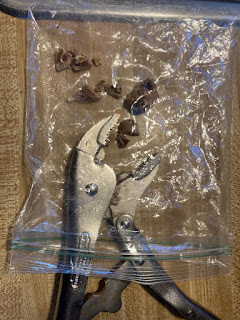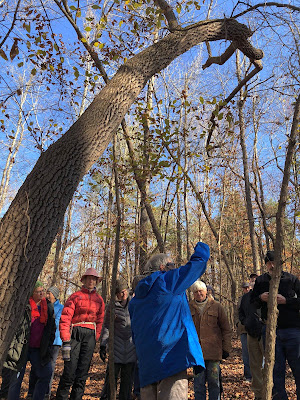Leader for today's Ramble: Dan Williams, forester/geologist
Authors of today’s Ramble report: Dan Williams (text and captions with quotation marks are taken from Dan's book, Tree Facts and Folklore: Identification, Ecology, Uses (traditional and modern), and Folklore of Southeastern Trees) and Linda. Comments, edits, and suggestions for the report can be sent to Linda at Lchafin@uga.edu.
Link to Don’s Facebook album for this Ramble. All the photos that appear in this report, unless otherwise credited, were taken by Don Hunter. Photos may be enlarged by clicking them with a mouse or tapping on your screen.
Number of Ramblers today: 36
Today's
emphasis: Trees in their wintery condition along the Purple Trail
Reading: “Gone to seed,” from the November 14 entry in An Almanac for Moderns, by Donald Culross Peattie.
Gone to seed. They are drear words, and we humans have
turned them to imply failure. In Nature, they mean success. Now the Wild Yam in
the woods has torn open its papery pod, and from its fine symmetry upon the
plan of three, the seeds escape. Old warty milkweed pods, silvering from their
summer greenish purple, split open now, and a glistening mass of down around
the flat brown seeds emerges between the valves. The goldenrod is a turret of
inflorescence in fulvous and gray tones; a breath of winter wind will bring the
cobwebby castle down. Summer’s prettiness is gone to seed, and become beauty.
Beauty, great beauty, is for me the fitting of the object
to its use, the truth of things. And the truth about this season is that now
the very birds are in their winter molt; the colors of the little mammals’ fur
are one with the bronze and silver of the woods, and, that, happily, in the
fields the flowers have gone to seed.
 |
| Goldenrod's fulvous, gray, cobwebby castle |
Show and Tell: Gary shared warm, homemade hickory nut milk that he made from Mockernut Hickory nuts, a technique he learned from Dan years ago. It was delicious! It takes about 20 hickory nuts to make a quart of nut milk. Cracked nuts and nutmeats (not the husks!) are boiled in water for about 30 minutes then sweetened with a bit of sugar or, even better, maple syrup. The nuts can be cracked using vise grip pliers inside a plastic bag to contain the flying shards of shell. Each cracked nut should be inspected for any spoilage. A few seconds in a blender can break the shell fragments into smaller pieces to separate more of the nutmeats from the shells before boiling. This link has a printable recipe and a video of a Cherokee woman making hickory nut milk.
 |
| Gary's vise grip pliers |
Announcements/Interesting
Things to Note:
Bob announced that a video of his November 2nd Word of Mouth presentation at The Globe, What Haunts the End of the Anthropocene, is now available on Youtube here. His poems address the effects of humankind on the living world and amounts to a prophecy, or warning, of a future that could still be avoided. You can also read his poems here.
Kathy announced a day-after-Thanksgiving walk, for Friday, November 25, at Sandy Creek Park. Meet at 1:00pm in the parking lot near the Cook's Trail trailhead, the first parking lot after crossing the dam and going up the hill.
Linda reminded us about the upcoming series of Winter Walks, beginning the Thursday following Thanksgiving, December 1. Walks will begin at 10:00am at state parks or natural areas within an hour's drive of Athens. Dale will announce by email the location and a description of each walk on the Monday prior.
Today's
Route: We left the Children’s Garden arbor and made our way through the International Garden to the Purple Trail, which we followed down to the spur
leading back up to the Flower Garden. From the Flower Garden we made our back
through the Heritage Garden, then the parking lot.
OBSERVATIONS:
 |
| Ginkgo leaves |
Ginkgo trees are famous for their toughness, shrugging
off air pollution, concrete mulch, and other urban indignities
to become the most widely planted street tree in America. They were among the
few trees to survive the blast at Hiroshima. Ginkgoes have had to be tough for a long
time, a really long time, with early Ginkgo relatives first appearing in the fossil
record over 290 million years ago, in the Permian era. These ancient plants survived
the “Great Dying” an extinction event which occurred about 252 million years
ago when massive amounts of carbon dioxide were released into the atmosphere by
volcanoes. Most animal species and many plant species disappeared but Ginkgo
family plants survived.
According to scientists who study plant fossils, Ginkgoes responded to the drastically increased CO2 in the atmosphere by reducing the
number of stomata on their leaves. Stomata are microscopic pores on the lower
surfaces of leaves that allow plants to take in CO2 for photosynthesis
but also let water escape. Plants like the ancient Ginkgoes that successfully balance the need to take in CO2 with the need to reduce water
loss have a competitive advantage over plants with more stomata.
Alas, this competitive
advantage did not help the Ginkgoes when flowering plants, with their superior
methods of pollination and seed dispersal, evolved about 120 million years later,
quickly overtaking more ancient plants that did not bear flowers and fruits. Ginkgoes
also suffered during the Ice Ages, and eventually dwindled to a few populations
in southwestern China. The species was saved from extinction by cultivation in gardens
at Buddhist temples and is now planted widely throughout China and much of the
developed world. Wild populations were recently
discovered in the Dalou Mountains in southwestern China.
 |
| Dan pointed out that Bigleaf Magnolia leaves, up to 30 inches long, are the largest simple leaves in North America. Their flowers are also the largest tree flower in North America. |
 |
| Beautiful old American Beech near the head of the Purple Trail |
Beeches are common trees in Piedmont forests, usually found on moist slopes, often in the sub-canopy. They are shade-tolerant: their seeds will germinate, and their seedlings and saplings thrive, in the deep shade of a hardwood forest. If a gap is created in the canopy, a Beech tree will seize the opportunity and quickly grow into the canopy.
 |
| "Cherokee Indians believed that Beech trees were never struck by lightning. Statistics verify this, though the cause is unknown." |
The vertical scars on this Beech tree are most likely not from lightning strikes, but are probably "frost cracks" that formed when there was a big difference in the winter between day and night temperatures. During the day the tree's wood warms up and expands slightly; when the temperature drops at night, the bark and adjacent layers cool down and shrink faster than the inner wood, causing them to split.
 |
| Beech leaves turn a coppery gold
in the fall, eventually becoming thinner and paler in color as they persist through the winter. |
 |
| Beech trees are one of several tree species at the Garden that hang on to their leaves during the winter, a phenomenon known as "marcescence." |
Chalk Maple is another Piedmont species
that holds its leaves during the winter.
 | |||
| Hop Hornbeam, with its "cat-scratch" bark, is another marcescent tree that is common at the Garden. |
 |
| Marcescent trees – Beech, Chalk Maple, and Hop Hornbeam – dominate the forest sub-canopy at the Garden. |
 |
| "Though Sourwood shoots are quite straight, the tree itself presents a very crooked growth pattern easily identified in the forest." |
 |
| "White Oak bark is light gray and very flaky." |
 |
| White Oak leaves are "simple, alternate, toothless, with rounded lobes; fall color is amber, red, orange." |
 |
| We will miss the magnificent Northern Red Oaks, with their "ski-trail" bark once they are gone from the Piedmont. |
 |
| Northern Red Oak Acorn (Photo by Don Mullen) |
- Pines with 3 needles per bundle: "Lob a Long Pitch into the Pond" will take you to Loblolly, Longleaf, Pitch, and Pond pines.
- Pines with 2 needles per bundle: "Virginia will Spruce up the Table Shortly," gets you to Virginia, Spruce, Table, and Shortleaf pines. (Shortleaf may have 3 needles occasionally, and Slash Pine 2 or occasionally 3 needles.)
- White Pine doesn't need a mnemonic; it is the only five-needle pine in Georgia.

Shortleaf Pine is also distinguished by the pinhead-size resin pits in its bark.
Dan D. Williams (2014), Tree Facts and Folklore: Identification, Ecology, Uses (Traditional and Modern), and Folklore of Southeastern Trees.
Dan D. Williams (2011),Tree ID Made Easier: A full color
photo guide, plus helpful hints for identifying major trees of the Southern
U.S.
Dan D. Williams (2012),The Rocks of Georgia: A full-color photo guide to Georgia's rocks, including what they look like, how they formed, and where to find them.
Dan D. Williams (2012), The Rocks of Great Smoky Mountains National Park: A full color guide to the rocks of the Park, including how they formed, what they look like and where to find them.
Also check out Dan's geology videos on Youtube. As an example, here's an intro to geologic provinces and another on "The Great Dying" extinction event he mentioned today. There are lots more geology videos and also videos on "van & tiny house" living: type "pixitrax" in the Youtube search window, then click on Playlists when his page comes up. Subscribe and make Dan happy!
Postscript: Eleanor sent in these wonderful photos of frost flowers in her yard...on Scarlet Salvia! I've never seen frost flowers form on any species except White Crownbeard, so this is a real treat. Thanks, Eleanor!
SUMMARY OF OBSERVATIONS
Ginkgo Ginkgo biloba
Bigleaf Magnolia Magnolia macrophylla
Musclewood Carpinus caroliniana
Milk-white Toothed Polypore fungus Irpex lacteus
North American Beech Fagus grandifolia
Hop Hornbeam Ostrya virginiana
Northern Red Oak Quercus rubra
Black Oak Quercus velutina
White Oak Quercus alba
Sourwood Oxydendrum arboreum
Cranefly Orchid Tipularia discolor
Chalk Maple Acer leucoderme
Loblolly Pine Pinus taeda
Eastern Redbud Cercis canadensis
Eastern Red Cedar Juniperus virginiana
Yaupon Holly Ilex vomitoria
Possum-haw/Deciduous Holly Ilex decidua
Eastern Hemlock Tsuga canadensis
















